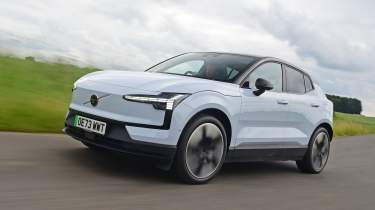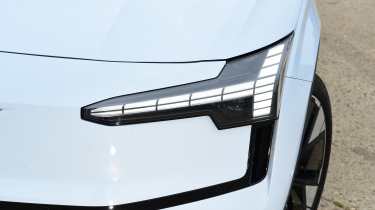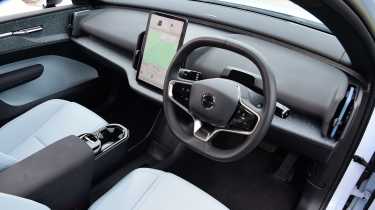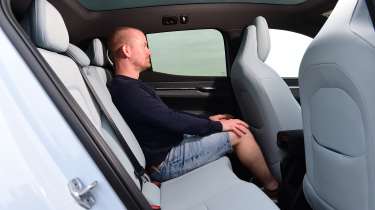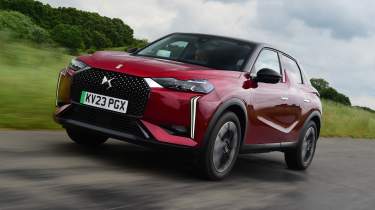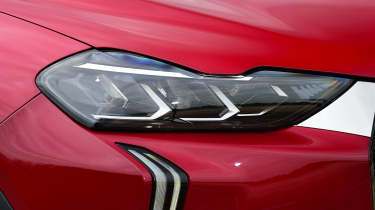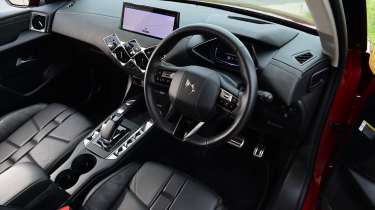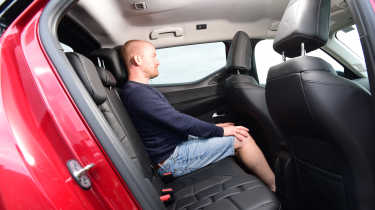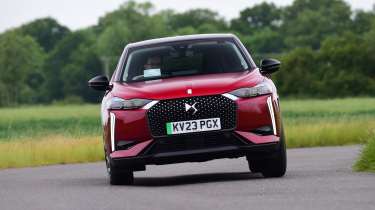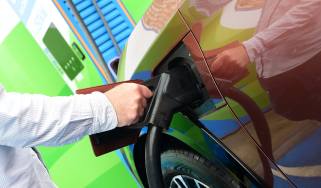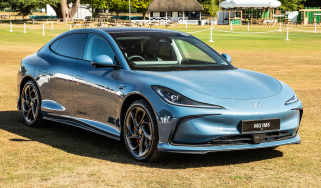Volvo EX30 vs DS 3 E-Tense: a small premium electric SUV skirmish
The Volvo EX30 signals a new era for the Swedish firm’s EV plans. We compare it with the DS 3 E-Tense
Downsizing. In the automotive world it’s a word that often implies compromise, suggesting that you might miss out on something grander.
However, it’s one that comes with more positives than you might think. If you can cram all of the luxuries of a large vehicle into a small one, then you’ll benefit from a car that’s more fun to drive, more efficient and can fit into parking spaces properly.
And when such a car looks as handsome as the Volvo EX30, then it’s certainly very appealing. Volvo is a manufacturer with big ambitions, setting itself a target that half of all of its global sales will be taken by full EVs by 2025. The EX30’s strong pricing, starting from just £33,044, will play a crucial role in achieving that figure – so is it any good?
To find out, we’re pitching it against another electric car that’s diminutive in size but big on premium appeal. The DS 3 E-Tense proudly presents its poshness with Gallic charm, and packs an electric powertrain and lashings of leather into its compact footprint.
It’s hard to find many cars that are as stylish as this for 40 grand, so it’s time to put them up to the Real-World Road Test to find out which is best.
| Volvo EX30 Single Motor Extended Range Ultra |
DS 3 Opera E-Tense | |
| Price: | £41,044 | £41,485 |
| Powertrain: | 1x e-motor, 268bhp/ 64kWh battery |
1x e-motor, 154bhp/ 51kWh battery |
| 0-62mph: | 5.3 seconds | 9.0 seconds |
| Efficiency: | 3.5 miles/kWh | 4.0 miles/kWh |
| WLTP range: | 295 miles | 245 miles |
Volvo EX30
The EX30 we’re testing is in the top trim level but with a single motor, rather than the more potent dual-motor version. With discounts applied at the time of writing, it’s priced from £41,044.
Tech highlights
At a moment when modern cars are growing ever larger, it’s refreshing to see Volvo’s latest model take up far less space on the road. At 4,233mm long, the EX30 is 33mm shorter than Volvo’s last attempt at a compact car, the C30 hatchback. For a more modern point of reference, the current Volkswagen Golf is 4,284mm long.
Used - available now

2026 Audi
Q2
8,765 milesAutomaticPetrol1.5L
Cash £22,300
2020 Cupra
Ateca
29,406 milesAutomaticPetrol2.0L
Cash £22,997
2022 Volvo
XC40
37,661 milesAutomaticPetrol1.5L
Cash £22,497
2024 Volkswagen
Golf
30,112 milesAutomaticPetrol1.5L
Cash £20,197Volvo has been able to dip into the resources of owner Geely for the EX30’s tech. Under the skin, it uses the Chinese giant’s SEA2 architecture, which is also used by the Smart duo, the #1 and #3. The Volvo’s stats, therefore, are very similar to those two; energy is supplied by a 69kWh battery (of which 64kWh is usable), while single and twin-motor versions are available. It’s the former we have here, and it sends a healthy 268bhp and 343Nm to the rear wheels. A heat pump is standard-fit on this model.
Sustainability is a key selling point for the current Volvo range, and that’s taken a step further with the EX30. All of the bits you can see are uniquely Volvo, including the materials used in manufacturing; there’s up to 25 per cent recycled aluminium, 17 per cent recycled steel and 17 per cent recycled plastic in each car.
Further aligning with its sustainability plans, from 2025 Volvo will move EX30 production from China to its existing plant in Ghent, Belgium.
Safety: Euro NCAP hasn’t tested the EX30 yet, but given Volvo’s safety-driven ethos, and the fact that NCAP awarded the mechanically similar Smart #1 five stars, we’d expect the EX30 to do well.
On the road
In many ways, the EX30 feels quite unlike any other Volvo to drive, yet a sharp driving experience doesn’t come at the expense of comfort.
Around town: Small dimensions and light, direct steering mean the EX30 is a doddle to drive at low speeds. The low dashboard line gives a brilliant view of the road ahead, while both the brakes and acceleration are smooth and responsive.
We’d like the option of more settings for the brake regeneration, though, and ideally accessed through steering wheel-mounted paddles.
A & B-roads: Most Volvo's offer little incentive to head for a twisty section of road, but the EX30 is different. There’s none of the wallowy feeling found in larger Volvo's here; instead the EX30 feels sharp, well balanced and grippy. It turns in keenly with just a tiny hint of body roll, and tightly controlled damping means that when you hit larger compressions, the springs settle quickly.
The car’s mass means that harsh mid-corner bumps can throw the car off course slightly, which can cause the stability control to nip at the wheels when you’re a little too enthusiastic. Yet by the standards of most cars in this class, it’s great to drive.
But for little steering feedback, it’s more fun than almost anything else in the segment. Then there’s the straight-line performance, which is superb.
Motorway: The EX30 remains pleasingly hushed at higher speeds, with wind rustle being the most noticeable (but not intrusive) noise while cruising. The ride remains composed, and stability is great, considering the car’s modest proportions.
While some EVs tail off when accelerating past 60mph, the Volvo’s rear-mounted motor still offers up strong acceleration when it’s needed.
Ownership
Volvo and minimalist design have gone hand in hand in recent years, and the cabin of the EX30 builds on that philosophy. As in a Tesla, there’s no instrumentation ahead of the driver; instead, everything is displayed on the central screen.
But as with Tesla, we can’t help but feel that Volvo has taken things too far. The majority of controls are confined to the touchscreen, and while we can accept that for certain things – many drivers will only adjust the door mirrors once, for example – others, such as the lights, should absolutely be something that can easily be switched as and when the driver deems necessary.
Visibility is something of a mixed bag. Looking forward, the view is fantastic, thanks to a very low scuttle and dashboard line. The slightly square-shaped steering wheel is great to hold, too. However, over the shoulder there is quite a large blind spot, due to a mix of a narrow back window and large C-pillars. At least the large door mirrors, whose frameless design maximise the reflective area, compensate for this somewhat.
The sustainability drive continues inside, with recycled materials including re-used denim and, as shown in our car, trim panels made from old PVC window frames and roller shutters.
Storage: That touchscreen comes into action even when you want to put stuff away, because there’s no physical handle to open the glovebox, just an on-screen switch. The next surprise comes when it opens, because rather than sitting ahead of the passenger, it’s right in the middle below the screen.
It’s clear that plenty of intelligent planning has gone into the EX30’s cubby spaces, though. A two-tier storage panel sits along the floor, giving plenty of space to hide smaller items, while the cup-holders pop out of the higher portion of the centre armrest and neatly stow away when they’re not needed.
Practicality
There are plenty of better choices out there if you’re after a practical small electric car, because space isn’t a strong suit.
Rear space: The EX30 is a similar length to EVs such as the Volkswagen ID.3, but it’s hard to believe that from the back seat. Rear kneeroom is tight compared with some rivals; it’s closer to posh hatches like the Mercedes A-Class than taller SUVs.
It’s not just kneeroom, either, because limited foot space under the front seats makes things feel tighter still. Headroom is fine, but that’s partly because the seat squab is set low to the floor.
Boot: At 308 litres, the boot isn’t great either, but the space is neatly shaped, and with the false floor raised to its higher position, there’s a completely level load area when the rear seat backs drop flat. Unlike the DS, the EX30 also has extra storage under the bonnet.
What to buy?
Which version we’d choose
- Powertrains: The three choices kick off with the 214-mile, 268bhp Single Motor; the Extended Range has the same power but can travel 298 miles, while the Twin Motor Performance makes 422bhp and can cover 286 miles.
- Trim: Buyers can choose from two levels currently. The Plus gets a 12.3-inch screen and a Harman Kardon hi-fi (a sound bar that spans the width of the dash), plus parking sensors all round. The Ultra adds a panoramic sunroof and 20-inch alloy wheels, plus a faster 22kW onboard charger. A cheaper Core trim will come later.
- Our choice: If you can live with the shorter range, then the Single Motor Plus is a bargain.
DS 3 E-Tense
The DS 3 E-Tense range kicks off from £36,715. The Opera trim we’re testing here, however, is more expensive than the Volvo, weighing in at £41,485 – and growing to £42,480 with the bold Diva Red paint of our test car.
Tech highlights
Dive under the skin and the DS 3’s layout is fundamentally different from the Volvo’s. Here, the motor powers the front wheels instead of the rears, and at 154bhp and 260Nm, it’s a full 114bhp and 83Nm down on the EX30.
Its other specs also lag behind; at 51kWh, the DS 3’s battery has 13kWh less usable energy than the Volvo’s, while its 100kW charging speed is 53kW slower. A 10-80 per cent top up (adding 35.7kWh) takes 30 minutes, while the EX30 can add 44.8kWh to its charge in 28 minutes.
If all of the DS 3’s specs look rather familiar, it’s because its electrical architecture is the same as a wide range of Stellantis small cars, including the Vauxhall Corsa Electric, Jeep Avenger and Peugeot E-2008. At 4,118mm long, the DS is among the more compact electric SUVs on the market, with an overall length that’s just 44mm longer than a Volkswagen Polo’s.
Safety: The DS 3 chalked up a maximum five-star rating from Euro NCAP when it was tested in 2019. While the safety experts’ standards have become more stringent in the five years that have since passed, its 96 per cent score in the Adult Occupant Safety category was a match for the highly rated Tesla Model 3 that was tested in the same year.
Lane-departure warning, speed-limit detection and all-round parking sensors are standard-fit on all DS 3 E-Tense models, while the Opera also adds blind-spot warning and adaptive cruise control with lane positioning.
On the road
There’s an easy-going nature to the DS 3, thanks to a soft suspension set-up, but in this company, the power and performance are also a little too soft.
Around town: The DS 3 is fairly relaxing to drive. There’s a greater focus on comfort here than in the EX30, and on slower urban roads, that can be felt with a touch more compliance over big bumps.
As the speed increases, that translates into a little less body control, because there’s an additional bounce before the car settles after each bump.
A & B-roads: In other uses of this e-CMP electric platform, we tend to go easy on the fact that its straight-line performance is generally behind the class best. After all, it’s fine for most people, and it’s usually a case that many rivals have more power than necessary, rather than the Stellantis models being lacking. But when the DS pitches itself as a premium option, those types of buyers demand a little more. That’s certainly the case against the Volvo, where the DS 3’s nine-second 0-62mph time is a full 3.7 seconds slower than its rival’s.
With a comfort-biased set-up, it’s never going to be sharp or fun to drive, but relatively compact dimensions and a low centre of gravity (courtesy of the heavy battery installed in the floor) mean the DS 3 is perfectly competent at flowing along a twisty road.
Motorway: At higher speeds, the DS 3 is a touch noisier than its rival. There’s not much in it – a little more tyre roar makes the difference – and it’s still more hushed than any petrol-powered car of this size. It’s here where the DS 3’s performance deficit is most obvious, too, because you really need to make the most of the accelerator pedal’s travel on a slip road in order to get up to an adequate speed.
Ownership
As you approach the DS 3, you’re presented with lots of subtle touches that hint towards its billing as a mini luxury car. The flush door handles that pop out as the car unlocks, the intricate detailing of the LED daytime running lights that streak down the edges of the bumpers and the smart alloy wheel designs all give an impression of expense.
To our eyes, the Volvo’s proportions and details look a little more contemporary, and some of the DS 3’s details, such as the kink behind the B-pillar that references the old Citroen DS 3 hatch, look a bit clumsy when applied to a small SUV bodystyle. Still, there’s lots of kerb appeal to be found here in the DS 3’s own uniquely French approach.
There’s no question that the DS 3’s cabin design is unique, and for some buyers that will be enough for them to place a deposit. The standard of finish is lifted by the close attention to detail that DS has paid to the cabin, such as the wonderfully soft leather that covers the seats and steering wheel in this top-spec Opera trim. However, some parts you frequently touch, such as the column stalks, don’t quite live up to the standards you’ll find elsewhere. In contrast to the open, airy feel of the EX30, the DS 3 feels much more snug, due to its high centre console and deeper, more prominent dashboard.
At four miles per kilowatt hour, the DS 3 proved to be more efficient than the Volvo by a decent margin. In the real world, that means the DS 3 should cover roughly 204 miles between charges; only 20 miles short of the Volvo, despite the Swedish model’s larger battery.
Storage: Aesthetics have taken priority over function inside the DS 3, and the upshot of that is the limited number of storage options. There’s a neat slot ahead of the gear selector for holding a smartphone and a reasonably sized central storage bin, but the glovebox is tiny.
Practicality
While the Volvo’s cabin is a little tight by class standards, beside the DS 3 it’s still the place we’d rather sit.
Rear space: The DS 3’s exterior design, where the window line kinks up towards the B-pillars, makes it feels a little more claustrophobic in the back than its rival, even before overall space is taken into account. And things are still a little cramped; rear kneeroom is roughly equal to what you’ll find in the Volvo, but head and elbow room are at more of a premium.
Boot: At 350 litres, the DS 3’s boot is 32 litres larger than the EX30’s, while its load lip is also slightly lower (but is still quite high). The seat backs drop in a 60:40 split and leave quite a big step in the load area when they’re folded. In this configuration, the overall volume climbs to 1,050 litres, which is reasonable for a car so small, and 146 litres ahead of the Volvo.
What to buy?
Which version we’d choose
- Powertrains: There’s just the single drive system available here. We’d like to see a little more punch for the amount of money that DS is asking for, though.
- Trim: Buyers can choose Performance Line or Opera models. The former gets part-Alcantara/part-fabric upholstery in place of the Opera’s full leather, and misses out on wireless smartphone charging and a few other creature comforts. Otherwise, it’s well equipped; LED lights, cruise control, acoustic front and rear glass, heated door mirrors and climate control are all standard. At £39,200, it’s £3,500 less than the Opera.
- Our choice: Plush though the Opera is, the cheaper Performance Line is what we’d have.
Results
Which car comes out on top?
Winner: Volvo EX30
Volvo has got a huge amount of things right with the new EX30. Performance, ride, handling and cabin ambience pretty much blow away any competition for a similar price – which is all the more impressive when you consider the desirable badge on its nose.
The rear seats are a compromise you can live with if you don’t carry adults often, but this makes the car’s main flaw – cabin ergonomics – all the more frustrating. With more use of physical buttons, this would be one of the best EVs money can buy.
| Pros | Cons |
| Composed handling |
Touchscreen reliance at the expense of ergonomics |
| Controlled ride |
Tight rear-seat space |
| Brilliant performance | So-so efficiency |
|
Cabin quality and finish |
Runner-up: DS 3 E-Tense
There’s plenty to like about the DS 3. It pulls off the compact luxury-car brief in some areas, most notably in its cabin appearance and materials, plus it has a fairly soothing ride. However, there are also plenty of downsides that prevent it putting up a serious fight to the Volvo.
Its EV tech feels a little dated, the rear seats are small and its performance falls short of its rival’s. The killer is its depreciation, though, so we’d only recommend it if you can find a bargain leasing offer.
| Pros | Cons |
| Classy and unique cabin design |
Underwhelming performance |
| Relaxing ride |
Steep depreciation |
| Strong standard equipment |
Fiddly ergonomics |
|
Limited rear headroom |
Which would you buy? Let us know in the comments section below…
Specs and prices
| Volvo EX30 Single Motor Extended Range Ultra | DS 3 Opera E-Tense | |
| On the road price/as tested | £41,044/£41,044 | £41,485/£42,480 |
| Powertrain | 1x e-motor/lithium-ion battery | 1x e-motor/lithium-ion battery |
| Power/torque | 268bhp/343Nm | 154bhp/260Nm |
| Transmission | Single-speed auto/rwd | Single-speed auto/fwd |
| Battery capacity/usable | 69/64kWh | 54/51kWh |
| Length/wheelbase | 4,233/2,650mm | 4,118/2,558mm |
| Height/width | 1,549/1,837mm | 1,534/1,802mm |
| Boot capacity (seats up/down) | 7/318/904 litres | N/A/350/1,050 litres |
| Kerbweight/payload/towing weight | 1,775/390/1,600kg | 1,550kg/458kg/N/A |
| Turning circle/spare wheel | 10.6 metres/repair kit | 10.7 metres/repair kit |
| Basic warranty (miles)/recovery | 3yrs (unlimited)/3yrs | 3yrs (60,000)/3yrs |
| NCAP: Adult/child/ped./assist/stars | N/A | 96/86/64/76/5 (2019) |
| 0-62mph/top speed | 5.3 seconds/112mph | 9.0 seconds/93mph |
| Auto Express economy/range | 3.5mi/kWh/224 miles | 4.0mi/kWh/204 miles |
| Claimed range (WLTP) | 295 miles | 245 miles |
| Charging capability | 7.4/153kW | 7.4/100kW |
| Charging time | 11h 30min/28 (10-80%) | 7h 30min/30min (10-80%) |
| Tax bracket | 2% | 2% |
| Number of airbags/Isofix points | Nine/two | Six/three |
| Parking sensors/camera | Front & rear/360 degrees | Front & rear/yes |
| Lane-keep assist/blindspot/AEB | Yes/yes/yes | Yes/yes/yes |
| Climate control/adaptive cruise | Yes/yes | Yes/yes |
| Leather/heated seats/wheel | No/yes | Yes/yes |
| Metallic paint/LED lights | £0/yes | £795/yes |
| Keyless entry & go/powered tailgate | Yes/yes | Yes/yes |
| Sat-nav/digital dashboard/USBs | Yes/yes/four | Yes/yes/two |
| Online services/wireless charging | Yes/yes | Yes/yes |
| Wireless CarPlay/Android Auto | Yes/no | Yes/yes |



